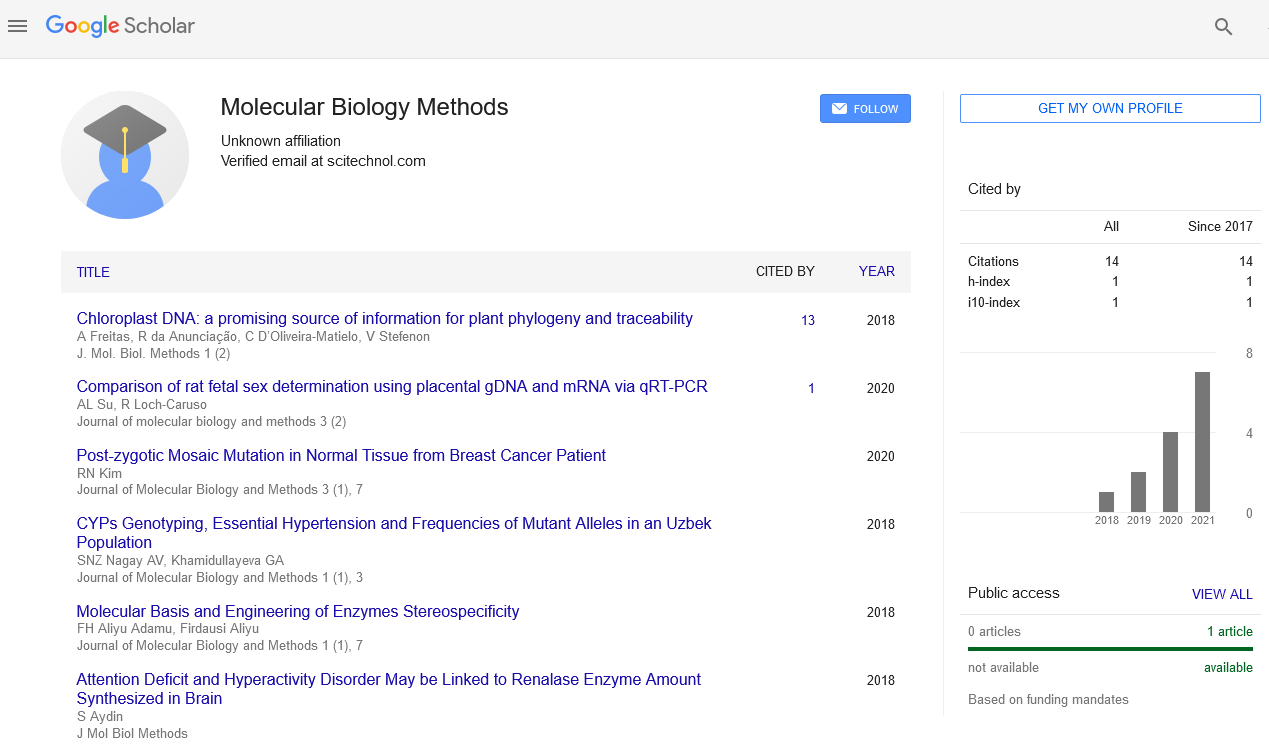Opinion Article, J Mol Biol Methods Vol: 7 Issue: 1
An Overview on Polymerase Chain Reaction: Significance and Future Directions
Geoffrey Tyo*
1Department of Chemical and Biological Engineering, Northwestern University, Evanston, United States of America
*Corresponding Author: Geoffrey Tyo,
Department of Chemical and Biological
Engineering, Northwestern University, Evanston, United States of America
E-mail: tyogeoffrey0948@ac.edu
Received date: 26 February, 2024, Manuscript No. JMBM-24-136930;
Editor assigned date: 29 February, 2024, PreQC No. JMBM-24-136930 (PQ);
Reviewed date: 14 March, 2024, QC No. JMBM-24-136930;
Revised date: 21 March, 2024, Manuscript No. JMBM-24-136930 (R);
Published date: 28 March, 2024, DOI: 10.4172/JMBM.1000152
Citation: Tyo G (2024) An Overview on Polymerase Chain Reaction: Significance and Future Directions. J Mol Biol Methods 7:1.
Description
Polymerase Chain Reaction (PCR) is a revolutionary technique in molecular biology that has transformed various fields such as genetics, medicine, forensics, and evolutionary biology.
Principles of polymerase chain reaction
At its core, PCR is a method for exponentially amplifying a specific segment of DNA. It relies on the enzymatic properties of DNA polymerase, the molecular machinery responsible for replicating DNA in living organisms. The PCR process typically involves three main steps: denaturation, annealing, and extension.
Denaturation: The first step involves heating the DNA sample to near-boiling temperatures (typically around 94°C-98°C). This causes the double-stranded DNA to separate into two single strands, effectively denaturing the DNA and breaking the hydrogen bonds between the complementary base pairs.
Annealing: After denaturation, the temperature is lowered (usually to around 50°C-65°C), allowing short DNA primers to anneal to complementary sequences on each of the single-stranded DNA templates. These primers serve as starting points for DNA synthesis.
Extension: Once the primers are annealed, the temperature is raised slightly (typically to 72°C), and DNA polymerase extends the primers by adding nucleotides to the growing DNA strand. The polymerase enzyme used in PCR is usually a thermostable enzyme, such as Taq polymerase, derived from the thermophilic bacterium Thermus aquaticus. This allows the polymerase to withstand the high temperatures used in the denaturation step.
By repeating these three steps in cycles, each cycle doubles the amount of DNA, leading to exponential amplification of the target sequence. After a sufficient number of cycles, there is a significant increase in the concentration of the target DNA, making it detectable and amenable to further analysis.
Applications of polymerase chain reaction
The versatility and sensitivity of PCR have led to its widespread adoption across various scientific disciplines. Some of the key applications of PCR include:
Genetic testing and diagnosis: PCR is extensively used in clinical diagnostics to detect genetic mutations associated with inherited diseases, infectious agents such as viruses and bacteria, and cancer biomarkers. Techniques like real-time PCR (qPCR) allow for quantitative analysis of DNA, enabling accurate measurement of gene expression levels and viral load.
Forensic analysis: PCR plays a crucial role in forensic science for DNA profiling and identification of individuals. Short Tandem Repeat (STR) analysis, a variation of PCR, is commonly used in forensic DNA typing due to its high sensitivity and ability to amplify minute amounts of DNA from diverse sources such as blood, saliva, and hair follicles.
Significance and future directions
PCR has revolutionized molecular biology and biotechnology, empowering researchers with a powerful tool for studying and manipulating DNA with unprecedented precision and efficiency. Its impact spans across diverse fields, from basic research and clinical diagnostics to forensic analysis and environmental monitoring.
Looking ahead, on-going advancements in PCR technology continue to expand its capabilities and applications. Innovations such as isothermal amplification techniques, microfluidic PCR devices, and portable point-of-care systems are driving the development of faster, more sensitive and user-friendly PCR platforms. Additionally, integration with other molecular technologies such as Next-Generation Sequencing (NGS) and CRISPR-based genome editing promises to further revolutionize genomic analysis and personalized medicine.
PCR stands as a cornerstone of modern molecular biology, enabling ground breaking discoveries and applications across a wide range of disciplines. Its versatility, sensitivity, and scalability make it an indispensable tool for researchers and clinicians worldwide, shaping our understanding of genetics, disease, and the natural world. As PCR continues to evolve and diversify, its impact on science and society is bound to grow, opening new avenues for innovation and discovery in the years to come.
 Spanish
Spanish  Chinese
Chinese  Russian
Russian  German
German  French
French  Japanese
Japanese  Portuguese
Portuguese  Hindi
Hindi 